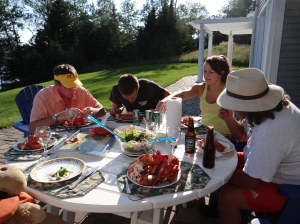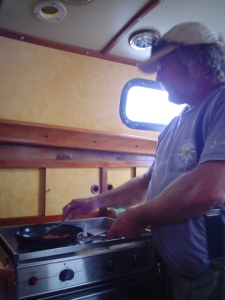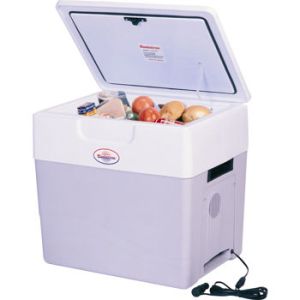

I would love to be able to eat out for almost every meal while sailing. But for obvious reasons, this is not practical. We have wonderful friends in many ports, who have invited us into their homes for more than one meal. I often try to reciprocate for at least cocktails and appetizers on the boat or a morning breakfast just before a sail. It is difficult to entertain people for a large meal on board but keeping the meal small makes it much more manageable. Breakfast is always my favourite meal to prepare! A special treat on a trip is at least one evening meal at the Lunenburg Yacht Club. It gives us time to relax, fill up on fuel and water, shower and greet friends and family while at dock! For once, we can be hosts for people on land, while travelling.
Eating out is easy but planning on provisioning the boat for a summer, week or weekend can be a challenge. I keep a full pantry on board, loaded up shortly after the boat hits the water in early May. Then at the beginning of each trip I load up the perishables, replenish the non perishables and off we are all set to go again. We usually have so much in our pantry, that we can easily live off it well into Christmas after we remove it all from the boat at haul out in November. What is a pantry on a boat? It can be anywhere, which is preferably dry and can easily hold non perishables. I have a space on the back of a bench seat, for small slender items, under the seat, I have more space, and a bit of space in the small cupboards. Organizing it is all by preference. Stuff you use daily, like coffee, tea, sugar, etc can go in the small cupboards within easy reach. Other stuff can be buried a bit deeper depending on size and need. This past fall, I actually listed all the items I removed from the boat. I thought it would be a good list to use for replenishment in the spring. A lot of this is personal preference as I might like one thing more than another.
BASIC PANTRY
Since our longest time away has been two weeks, I make sure I have at least enough for two weeks of meals. We do eat and visit with friends a lot, so the most of our food is consumed when we have guests over. My favourite meal for guests is breakfast/brunch. Our first month at the marina after we bought Rainbow I was noted for the best breakfasts on the dock!

Canned Goods: Rule of thumb, if there is any possibility cans getting wet, remove the paper labels as they could end up in the bilge and write on the can with permanent marker the contents. Abbreviations can work. eg: SS=Spaghetti Sauce. I prefer to buy items in a plastic reusable container even if it costs more.
- whole white potatoes and sliced white potatoes: 2 cans of each
- corn niblets, 2 cans
- cream of corn, 2 cans
- vegetables, 4 cans
- cranberry sauce: 2 cans
- chunky soup, beef and chicken noodle: 2 cans
- smoked mussels: 2 cans
- kippers and/or sardines: 2 cans
- shrimp and/or crab: 2 cans
- fruit, 4 cans
- turkey, chicken, ham and/or corned beef, 3 cans
- spiced tomatoes (Italian, etc), 2-3 cans
- tuna: 2 cans
- baked beans, 2 cans
- kidney beans: 2 cans
- pasta sauce: 2 cans
- coconut milk
- evaporated milk
- condensed tomato soup: 2 cans
- condensed cream of chicken, mushroom, celery soup; 3 cans
Other packaged goods:
- Bisquick mix or equivalent, 2 boxes (I use this so much that always have one on the go and an extra to use. I also found another brand of similar product in plastic pouches, small portion sizes, but work better.)
- cereal (I like the mini boxes of assorted cereal, but also have a favourite that I remove from the box and secure the opening and bring on board.)
- rolled oats (single serving in regular and assorted flavours)
- cookie mix
- ginger snaps (does relieve nausea!)
- stove top stuffing, 2 boxes
- chocolate (instant sugar fix and keep some in your ditch bag!)
- ginger candies
- flavoured rice, 2 pkgs
- flavoured noodle side dishes, 2 pkgs
- instant or scalloped potatoes, 2 pkgs
- crackers, soda, 1 small box (2 sleeves)
- crackers snacking: 2 boxes
- powdered skim milk
- kraft dinner, 2 pkgs (I prefer the small single portions for kids).
- dry pastas, spaghetti & pennes are our favourites, 2 pkgs
- granola or breakfast bars, 1-2 pkgs
- Kraft pizza mix or equivalent, 1 pkg
- small bags of snacks including, chips, pretzels, popcorn, etc, 2-3 pkgs
- dried fruit, 2-3 pkgs
- dried cranberries, 1 pkg
- raisins (in individual boxes), 1 pkg
Staples and Sauces: Whenever possible, I purchase items stored in plastic containers, not glass.
- Worcestershire sauce
- soya sauce
- hot sauce
- bbq sauce
- sugar
- flour (add a whole bay leaf to avoid bugs)
- curry sauce (type that liquid is required to make)
- gravy: 2 pkgs (type that liquid required to make)
- honey
- peanut butter
- ketchup
- green relish
- mustard
- bullion packets (handful in both beef and chicken)
- dry grated Parmesan cheese
- pancake syrup (genuine maple syrup needs to be refrigerated)
- lemon juice
- salt, pepper and assorted spices (I reuse the same items in containers each year and store them in a cool dry place over the winter).
Beverages: I seem to be prepared for a party. But you never know what you need and how much. I like a variety of stuff to drink for both adults and kids.
- hot chocolate
- ground coffee
- tea bags (assorted flavours)
- tetra juice packs, 8-12
- clamato juice cans, 6-8
- Koolaide jammers, 12-24
- diet ginger ale cans, 24
- diet cola, 24
- regular cola, 24
- cranberry juice, plastic bottles: 6-8
- water in plastic bottles: 8-12 bottles (we drink tap water, but bottles of water are more convenient to offer guests while sailing.}
- UHF flavoured tetra packs of milk in strawberry and chocolate
Items Kept at Home to Bring Back to Boat each Trip: These are my guilt pleasures. Some things possibly can stay on board, but I take them home each time I go.
- pressurized cream topping (I use lite or full real cream not oil product.)
- jams (will last long if in a fridge)
- Miracle whip or mayo (can be left on board and not refrigerated, but be careful not to cross contaminate).
Wraps and Containers: I like to reuse containers which were originally purchased with a food product. Odd small and large sizes work best. I also have the following on the boat and most last the full season:
- clear garbage bags in both large and small sizes, 12-24
plastic grocery store bags, 12Only paper bags are now used in NS in all retail outlets.clear or blue bags for recycling, 12-24I now use clear bags for both garbage and recycling.- plastic wrap on a roll (remove box with cutter as it gets damp and moldy.)
- foil on a roll (remove box.)
- large zip lock bags (remove from box and place all bags inside one bag.)
- small zip lock bags (remove from box and place inside bag with large bags.)
Fresh Items I like to Bring Each Trip: (The quantity depends on how long we will be gone. Whatever can be frozen ahead of time will keep longer or keep other items cold longer).
- pork chops
- bacon
- mild Italian sausages
- eggs
- previously cooked beef roast in shrink wrap with gravy
- previously cooked turkey in shrink wrap with gravy
- cheddar cheese
- mozzarella cheese
- individual cheese slices
- cream cheese spread/dip
- tomatoes
- green onions (grow your own on board and refer to my pin on Pinterest).
- pepperoni
- apples, oranges or other seasonal fruit
- red, yellow, orange or green peppers
- baby carrots
- blueberries
- bread, rolls or croissants (refrigerator roles are fun to bake on the boat)
- frozen pie crust
- margarine
- milk
- one large onion any flavour
Meals on the Boat: I keep a number of “boat” recipes on hand list them on a separate page.

Tricks for Keeping Things Cold (AKA, How to pack the cooler): The cooler is electric, and to avoid draining the battery we only use it, when the engine is running. The engine is our generator. I bring along enough frozen pre packs (the blue ones you buy for coolers) and besides putting them in the ice box, I line the bottom of the cooler with them. I divide the cooler into two sections. One as wide as a 2 litre container of milk. That small section is closest to the condenser. There I place the milk, cheese and other dairy products. I also place my personal stash of ice cubes for drinks. The ice cube “tray” is actually a small frozen yogurt container with very small frozen ice packs and a sandwich sized zip lock bag containing ice cubes. The other and larger end of the cooler/fridge (and potentially less cold end), I place all frozen meat products on the bottom, on top of the cold packs. I make sure that any raw meat, although frozen, is double wrapped. Above that I place other frozen products and at the top I place items that can tolerate more moderate temperatures, including eggs, margarine and fresh vegetables that might require the cold. In the boat’s ice box I place previously cooled beer, wine and coolers and on the top and bottom of those beverages, I place ice packs. I rarely use ice. I sometimes freeze 2 litre pop bottles with water and freeze, which when thaw gives us additional drinking water. I have a metal shelve in the ice box, where I place condiments that I keep all the time on the boat, such as ketchup, mustard, etc, and then place any fresh fruit and vegetables that didn’t make it in the cooler on the very top along with more ice packs. As days go by the ice packs in the ice box thaw, things are eaten, and any remaining fresh fruit and vegetables are moved to the electric cooler. We run the boat’s engine during travel and in the evening at a mooring or at anchor until just after dark to keep the batteries up with the fridge running. From then until the morning, the cooler/fridge has to act as a cooler rather than a fridge, and this is when it relies on the ice packs to keep things cold. If we are at a dock, then we can use shore power and the fridge is plugged in at all times! A treat. In the morning the motor is turned on again to start the whole generator process.
At home, I pack anything that requires refrigeration in small soft coolers ensuring cold packs are in each. I often use about 4-5 of these coolers for each trip.
Check out Pinterest for any potential new boating stuff that I might find useful.

One thought on “What and Where to Eat?”